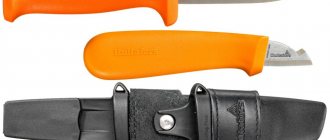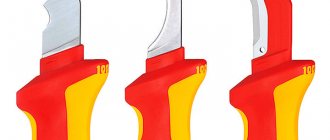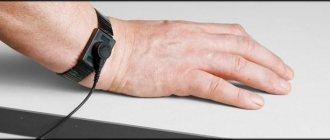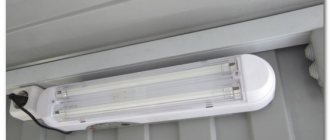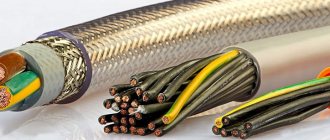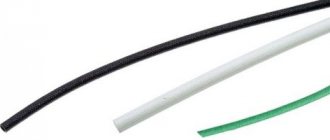A stripping knife with a special heel is a great invention that makes the electrician’s work easier when cutting cables and wires. With its help, the painstaking work of stripping the outer sheath of the conductor turns into a simple operation that takes only a few seconds. However, the price of the finished product in the store is a significant amount, which makes the user think about the advisability of such a purchase. It’s one thing for a professional electrician to be faced with the need to use it every day, but for a home handyman such a purchase would be an unjustified waste. There is a way to solve this problem by making your own electrician's knife. In the article we will tell you how to make a knife with a heel for removing insulation, and we will give detailed instructions.
How to make a knife sheath with your own hands
The knife can be conveniently stored in its sheath. You can also make them yourself from scrap materials.
Materials and tools
Good sheaths can be made from different materials: leather, plastic, wood. Craftsmen make sheaths from birch bark and PVC pipes.
The tools you will need are strong scissors, a thick needle, an awl, spring clips, and strong threads.
Manufacturing instructions
To make a leather sheath, a piece of leather is taken, a knife blade is placed on it and an outline is drawn. The material along the edge of the pattern is folded in half, and a blank is cut along the contour with a margin of 5 mm. A seam line is marked along its edge, and holes are drilled along it. A strong thread is sewn through them. Before stitching, you can coat the joint of the leather halves with glue.
A loop should be attached to the top of the sheath to allow the sheath to be carried on a belt.
Making a sheath from thick leather PHOTO: youtube.com
Features of working with an electrician's knife
The knife with a heel is quite popular among electricians. Its beauty lies in its design. At the end of the blade there is a small drop-shaped “heel” (width about 5 mm and length – 10 mm), thanks to which it is possible to avoid damage to the internal insulation of the wiring and the conductors themselves.
To start cutting, you need to insert the knife blade under the insulation - this can be done by first cutting the edge of the shell or by gently rocking the knife from side to side. When the “heel” enters the cable, the electrician just needs to rest the knife against the conductors and pull it away from him. Thus, the “heel” moves inside the wiring, the blade cuts the insulation along the wires to the required length.
The double-edged blade of the knife for terminating twisted pair cables with a “heel” allows you to strip wires from the back surface as well. To perform such a cut, it is enough to insert the “heel” under the cable insulation and cut along the wires towards you. It cuts perfectly in this way, ensuring simplicity and high speed of processing even long cables.
Regardless of whether the insulation is cut with the front or rear blade, working with a knife equipped with a “heel” is convenient and simple. One of the most important advantages of such knives is that when working with multi-core tinned or ordinary single-core wires, their blade will never come off and hurt your hands.
How to use an electrician's knife with a heel
We got acquainted with the device, now let's see in practice.
In my work, I most often encounter VVG cable with a cross-section from 1.5 mm2 to 6 mm2. Sometimes you have to work with PVS brand wire. Therefore, now we will try to cut all these cables using the knife described above.
Example 1. We strip the VVG-P 3x2.5 mm2 cable with an electrician’s knife
In order to cut the cable, we place the heel under the insulation. To make the heel fit easier, some comrades make an incision first, but I deepen the heel by lightly swinging the knife left and right, the outer insulation is cut through, thereby the heel easily fits under the shell.
Then we carefully pull the knife away from us along the cable, thereby cutting the outer insulation along the cores
to the required length. The heel slides inside the cable, and the blade cuts the insulation perfectly.
When cutting wires with such a tool, the likelihood of damage to the insulation of the cores and the cores themselves is reduced to zero. As you can see in the photo, the insulation of the current-carrying conductors remains intact and unharmed.
We did the cutting with the front blade. Let's try to do the same with the rear blade. We deepen the heel under the shell and smoothly move the knife along the veins towards ourselves.
The insulation cuts through perfectly in this direction as well. Another advantage of a knife with a heel leaves your fingers intact, but you still need to be very careful and work with gloves.
It doesn’t matter at all which blade you use to cut the shell, the back or the front. There is no difference here, and everyone works as they are comfortable
For some, it is more convenient to hold the knife away from you, for others, vice versa.
As you can see the knife with the heel of the STOCK
removes insulation from VVG cable with a cross section of 3x2.5 mm2 without any problems. Let's move on to the next example.
Example 2. Stripping the insulation from the VVG-P 3x1.5 mm2 cable
The next example for our knife will be a cable with a slightly smaller cross-section - 3x1.5 mm2. In this case, the heel fits a little tight under the insulation.
If you are unable to pick up the insulation with your heel, you can use regular pliers or thin-nose pliers. Lightly squeeze the edge of the cable with thin-nose pliers; an empty space is formed between the wires, into which the heel of the knife can easily fit.
Then we push the knife away from us and cut the outer insulation of the cable.
Let's now try to work while holding the knife towards ourselves. The blade cuts through the shell in both directions with ease.
Example 3. We strip the VVG 2x1.5 mm2 cable with an electrician’s knife
I came across reviews on the Internet where guys complained that it was difficult to cut cables with a cross-section of 2x1.5 mm2 or less with such a knife. The heel is large compared to the width of the cable and fits tightly under the sheath. Let's check it out.
We take a piece of VVG-P cable with a cross-section of 2x1.5 mm2 and try to cut it.
Yes, indeed, relative to the width of the cable, the heel is a little large.
To get the heel under the shell you need to apply a little force. The heel fits under the sheath with a stretch, so you have to push the knife with little effort. Not because the blade is dull and does not cut well, but because the heel is tight. There is effort, but you can work.
When cutting, the knife moves away from you easier than when cutting the insulation towards you. In addition, in the latter case, there is a high probability of injury if the knife comes off.
Example 4. Using an electrician’s knife, remove the insulation from a 3x1.5 mm2 PVA wire
Now let's try to cut a round wire of the PVS brand and see how an electrician's knife works with a heel
will cope with this task. The external insulation of PVA fits very tightly to the cores and it is quite difficult to fit the heel under the insulation.
We insert the tip of the heel between the veins and swing the knife and cut through the edge of the outer shell. Then we push the knife away from us and cut through the insulation further. The knife passes. It's a little difficult, but it goes away. Of course, cutting a flat cable is much easier and faster, but if you get used to it, you can also remove it from a round one, although it takes a little more time.
The lower the ambient temperature, the more difficult it is to remove the insulation from a PVA wire with such a knife - the insulation in the cold becomes simply oak. Accordingly, if you work with PVA or NYM, it is better to work in a warm place.
Another point that I would like to draw your attention to, friends, is the voltage for which the insulation of the knife handle is designed. According to the passport, the insulation can withstand voltages up to 1000 Volts
Although it’s hard for me to imagine how such a knife can be used under voltage.
Types of stripping knives
There are several types of insulation stripping knife:
- With heel or plow . Its blade is a sickle-shaped plate, at the tip of which is attached a slightly convex metal circle or drop-shaped element. This is the heel. It serves as a limiter for the depth of the cut. This electrician's knife is convenient for working with wires that have a hard sheath. Its dissection requires effort, and the heel will not allow you to accidentally damage deeper layers than required.
It is advisable to use this lineman's knife when the upper cable sheath requires separation, but the lower one must be left intact. The edge of the heel is placed behind the cut protection and the knife is pulled along the wire. As a result, the blade cuts the outer insulating layer.
- With a "beak" . The tool also has a curved blade, but its curve is smoother than in the previous case. The tip of the blade is pointed, there is no limiter. Knives for stripping and cutting cables of this series look simpler than plow knives, but in fact they are more difficult to work with.
The absence of a heel in inexperienced hands can lead to damage to the conductive core of the wire, because the specialist has to determine the depth of the cut and the force of impact on the protective layer independently.
- With a hook . The blade of this stripping knife is a straight blade with a notch on one side. It forms a hook on the tip of the blade. The edge of the blade itself has a blunt edge. Usually only the hook is sharpened. But there are also models with a sharpened opposite side of the blade.
This tool is quite convenient for a specialist to strip any type of cable. A knife is especially helpful when you need to remove the sheath along the wire.
- With a straight blade . Outwardly, this is the simplest weapon with a rounded butt. Typically, the blades of such instruments are very sharp, and therefore they can cut and separate the thick, hard shell. But to work with the knife you need experience, since it does not have a cut thickness regulator.
The listed types of professional electrician tools are basic, but among them there are special subcategories.
We recommend reading about the characteristics and types of folding knives. From the article you will learn about what to look for when choosing a folding knife, the best folding knives of foreign and Russian production. And here is more information about the features and types of fish knives.
Dielectric
A dielectric knife is one whose handle is entirely made of insulating material. This component does not allow current to pass through, thereby making the tool safer. They can work in conditions where it is not possible to disconnect the cable being stripped from the network. But the voltage level at which the use of the tool remains safe for a specialist must be indicated on the handle.
You should look, for example, for the inscription that this is an insulated cable cutter up to 1000 V. We are talking about alternating current here. The maximum DC voltage when working with such a tool is up to 1500 V. This group includes products:
- KVT NMI-01,
- KVT NMI-02 (without heel),
- Shtok 1000V VDE 14003,
- NWS 2043K.
Shtok 1000V VDE 14003
Knives with a partially insulated blade also fall into the dielectric category. One side is covered with the same material from which the handle is made, the second (blade) is a working metal, sharp one. Examples of such tools:
- Knipex KN 9855,
- Knipex KN 9854,
- VIRA VDE 397032,
- Haupa 200007,
- KVT NMI-05.
KVT NMI-05
For electrician folding
An electrician's folding knife is a special category of tools, distinguished by the ability to hide the blade in a groove in the handle outside of the work process. These are tools with a hook or “beak”, as well as a straight blade. The knife with the heel is always monolithic.
The folding one is more convenient to store, since it will not become dull due to the contact of the blade with the metal parts of other tools and will not injure the hand of the master when searching in the bag. Moreover, such products have a lock that prevents accidental opening of the knife. And a special lock firmly holds the blade in working condition, that is, it cannot fold involuntarily.
These knives can be multifunctional when, in addition to the cable stripping blade, there is a screwdriver and other additional blades. Folding types include:
- Topex 17B656,
- KVT NM-06,
- KVT NM-07,
- KVT NM-08,
- WEDO 200 mm WD549-02,
- Haupa 200014,
- NWS 963-1-85,
- NWS 963-2-85.
Haupa 200014
With KVT heel
Knife with heel KVT comes in the following types:
- NMI-01 . It has a non-slip two-component handle with a dielectric coating, the total length of the gun is 175 mm. The knife is suitable for working with multi-core cables, not suitable for coaxial cables. It is better to work with it when stripping the wire from yourself, using an external blade. The gun costs 1100-1250 rubles.
- NMI-01A . This tool, in addition to a safe handle with a finger rest, has a partially insulated blade. Therefore, they can work with wires energized up to 1000 V. The blade is made of stainless steel with a hardness of 51-53 HRC. The total size of the knife is 195 mm. It is more convenient for them to cut the wire sheath in the position of the outer blade “away from you”. The price of the product is 1300-1350 rubles.
Both KVT tools are matched by Shtok, NEO Tools and Haupa knives; they are identical in overall size and heel size. You should not use any of the tools if you have to work with small-section wire - 2×1.5, 3×1.5, 2×2.5. The KVT heel is too big for such diameters.
Watch this video for a review of electrician knives with a heel:
For cable stripping GOST according to TU
Wires manufactured in accordance with GOST 31996-2012 and created in accordance with the specifications differ in that in the second case the thickness of the conductive cores and insulating protection may be less than those required by the standard. That is, stripping such a cable must be more careful, and the tool for the job is selected accordingly.
The process of removing insulation from a TU wire is easier, but there is a danger of damaging the core. Therefore, you should choose a knife that is not the sharpest, with a small heel or no heel at all.
When working with a cable made according to GOST, it is better to use a high-quality and sharp tool. The sheath of such a wire is usually dense and rigid, making it more difficult to remove. In addition, it fits more tightly to the conductive core.
Chinese red knife LS-55
Knife LS-55 made in China costs 550-600 rubles. has the following features:
- a short, completely plastic handle of red color, with recesses at the end that allow you to fix the protective cap;
- blade set slightly askew;
- teardrop-shaped, small heel with well-polished edges.
LS-55
Experts call the dull blade a disadvantage of this weapon. Therefore, at the beginning of working with the cable, it should be clamped with pliers, only then insert the heel into the opened “pocket” and cut the sheath. The incision is made away from you; with a different direction of movement, the protective layer will be wrinkled and not cut.
KVT NMI-01
The KVT NMI-01 tool was discussed above, because this is the first modification of the KVT knife. It is worth adding that it has a large heel, which is difficult to manage with most types of cables. Therefore, craftsmen prefer to reduce it and make it more convex, thinning the edges of the part. Before work, the heel should also be checked for strength, since due to insufficiently reliable welding it may fall off.
KVT NMI-01
Knipex KN 9855
The Knipex KN 9855 knife is the most expensive (RUB 3800-4200) and high quality, with the following characteristics:
- comfortable, small heel;
- crescent-shaped partially insulated blade made of stainless medical steel,
- length 155 mm,
- presence of a recess for the thumb on the handle,
- the ability to strip wires under AC voltage up to 1000 V and DC voltage up to 1500 V;
- transparent cover.
Difficulties when using Knipex KN 9855 may arise when working with GOST cable (especially thin, but with rigid protection); the tool has a too soft blade for it. But if you choose the right angle for the metal to enter the shell, it will be possible to remove it in this case too. It is better to move the tool away from you, otherwise it is easy to get injured due to the sharpness of the blade. But you will have to sharpen it only after a couple of years of intensive use.
Sata
Sata can be called another analogue of the KVT NMI-01, because it is also a knife with a heel, matching in length and other dimensions with the mentioned tool. Its length is about 180 mm, weight – 67-70 g. The product costs 800-1000 rubles. The Chinese Sata has a rubberized handle, and the blade is attached to it at a slight angle, which is much more convenient for work than a straight fit. The handle also has a grooved part for the thumb. This helps you hold the tool more securely.
The disadvantage of Sata is the low quality of the blade. The heel is often loosely welded to the base of the blade. And the void present in this area makes it difficult to cut the cable protection due to the loose fit of the cutting edge to the surface of the sheath.
Sata
N.W.S.
The German NWS, costing 2200-2500 rubles, is distinguished by an ergonomic handle with grooves for fingers. True, this part is slightly longer than that of other knives, which is not very convenient. The heel is attached to the base of the blade with an angle, its size is small. Therefore, the tool is useful for stripping cables with a small cross-section.
The disadvantage of NWS is the quality of the steel. When cutting a dense cable and accidentally contacting a conductor, nicks may form on the blade.
N.W.S.
Jokari
The Jokari VDE Cable Stripper JK knife, priced at 3200-3500 rubles, differs from others in its plastic handle without inserts or corrugations. It would be inconvenient, but the tool has an excellent blade. And the heel has such a size and shape that you can start cutting the wire sheath from the middle. The part is oval, with raised ends. True, with intensive use the blade has to be sharpened quite often.
Jokari also has tools without heel, but:
- with adjustable cut size, insulated handle – Jokari Secura JK 10280 (cable diameter 8-28 mm);
- with a titanium-coated blade, the same characteristics as the previous copy - Jokari JK 10162 Standart (cable diameter 4-16 mm).
Jokari VDE Cable Stripper JK
The line includes other knives of the Sekura and Standart types, but of different sizes, therefore designed for working with wires of different sections.
How to make a knife with a heel yourself?
As we have seen, a repair knife equipped with a heel is a very convenient tool that has serious advantages. However, it has one serious drawback - the high cost, due to which many people cannot afford such a purchase.
However, you can make such an electrician’s knife with your own hands; this procedure does not present any difficulties. Let's take a closer look at how to do it and what we need for this.
Materials for work
To make a homemade knife with a heel for stripping wires, you first need to stock up on the accessories that are listed below:
- Blades for a stationery knife (2 pcs.)
- Aluminum profile from which the handle will be made. A piece of metal base from a mosquito net used in PVC windows is quite suitable.
- The rail is made of wood, which should be somewhat inferior to the profile in its cross-section.
- Soldering iron with POS solder and phosphoric acid.
- Diamond cutting microdisc.
- Bormashinka.
Having prepared all the necessary materials and tools, you can proceed directly to assembling the knife with the heel.
Manufacturing procedure
A homemade repair knife is made in the following order:
- Cut a spike on a stationery blade to which the heel will be attached.
- Grind off the excess sharpening so that only the edge remains sharpened.
- Sharpen the opposite side of the blade.
- Make a heel with a slot from a piece of the second blade that will correspond to the thickness of the cutting blade.
- Using a soldering iron and solder, attach the manufactured heel to the first blade. Give its edges an oval shape so that during operation of the tool it cannot damage the insulation of the cores and their metal base.
- Insert the blade into a piece of metal profile and secure it inside using a wooden strip with a cut.
- Drill a hole in the handle so that it is aligned with the one already in the blade.
- Insert a bolt into the hole and secure it with a nut on the other side.
At this point the work is completed, the tool is ready for use.
A slightly different technology for making a knife with a heel in the video:
Making an electrical installation knife with your own hands (step-by-step instructions)
As can be seen from the information presented, the insulation stripping tool is a useful and convenient device, however, due to its high cost, it is not always available to people who cut wires only periodically. However, you should not refuse the opportunity to become the owner of such a device and make it yourself at home.
There are several ways to make a knife with a heel. This publication will discuss the two most popular options:
- from the blade of a stationery knife;
- from a metal strip.
Both methods give good results, so the choice largely depends on the availability of a certain tool that will be needed during the work.
Option one (from a blade from a stationery knife)
Blades are sold with the knife or separately. For manufacturing you will need two such parts. Next, the entire process is indicated in the form of sequential actions:
- Procedure for cutting a ledge using a drill and a diamond blade
A ledge is cut out at the end of one of the blades, onto which the heel will later be attached. The required cut is made using a drill and a diamond microdisc. - If the goal is a knife capable of cutting insulation in both directions, then the back of the protrusion must also be sharpened
- A piece is separated from the second blade, from which the heel of the future knife with a slot is cut out using a drill with a diamond disk. The length of the slot should match the length of the projection made on the first blade
- Insert the protrusion into the heel slot, then use a soldering iron and POS tin-lead solder to perform high-quality reliable soldering, fastening the workpieces together
Practical advice: To secure the heel, it is recommended to use POS-60 or POS-61 solder, which can melt at a temperature of 190 °C, which will preserve the hardness and strength of the blade metal.
- Process the heel with a file until it forms an oval shape, and then sand the soldering areas. The result should be the product shown in the photo:
Appearance of the heel soldered to the stationery blade
- The final stage is making the handle. To make it, you can use plywood or plastic, from which you can cut out pads and attach them to the blade using epoxy glue.
The resulting product cannot be used as a professional tool, but for periodic use for domestic purposes, it may well become an indispensable assistant . The disadvantage of the described method is the inability to create a crescent-shaped (curved) blade, like branded analogues, but the final price and rare use can shift this omission to the background.
Option two (from a metal strip)
This method does not require the use of a special tool, such as a drill, or special skills, such as using a soldering iron and complex solder. In addition, it allows you to give the working body of the knife any shape convenient for the user. Considering that the tool being manufactured must have sufficient strength properties, be sharpenable and be able to maintain the sharpness of the cutting edge, it is recommended to use a piece of strip of high-alloy carbon steel with a thickness of 3-5 mm as a workpiece.
Step-by-step actions alternate in the following order:
- On a steel strip, the shape of the future tool is marked with a scriber, taking into account the length of the heel, after which all excess metal is cut off using an angle grinder (“grinder”)
Approximate marking of a knife blank with a heel on a piece of metal strip
- Using the same “grinder”, metal is sampled at the border of the blade and heel, and the thickness of the material in the area of the intended blade is reduced. Thus, the heel begins to stand out in length and width from the base of the blade
- The crescent-shaped part of the workpiece is sharpened on both sides and ground
- The heel is also thoroughly polished. The quality of the knife’s operation and the integrity of the insulation of internal current-carrying conductors will depend on the smoothness of its lower surface.
- The handle, as in the previous version, can be made of wood or plastic, or can be made of a piece of hose stretched over the back of the workpiece and sealed in a heat-shrinkable tube.
This method may seem more labor-intensive, but the resulting product will be strong, durable and flexible to edits.
Product selection criteria
A cableman's knife for stripping insulation is a tool that has a large number of varieties that are widely represented on the market. Their production is carried out not only by domestic brands, but also by foreign companies. The tool should be safe and simple, so when purchasing it, you need to consider the following factors:
For example, a set of knives for cutting NNRK (EMI) cable. Using it, you can make longitudinal and transverse cuts in aluminum and lead sheaths with a thickness of 2 to 5 mm and easily remove it from a cable with a diameter of 25−60 mm. Also in a large assortment of NNRK for performing complete cutting of cables made of cross-linked polyethylene, the voltage of which is from 1 to 35 kV. Not only classic models are provided, but also innovative ones that will greatly facilitate this installation stage.
Then one of the points was reserved for the electrician’s knife. Using this device, you can quickly remove the protective sheath of the cable. Today, the cost of a high-quality knife with a heel exceeds 1,000 rubles, so not every home craftsman can afford to purchase one, especially considering that electrical installations are not performed very often at home. You can solve the problem quite simply - make a knife with a heel for removing insulation with your own hands. Below we will provide instructions in pictures that will clearly show all stages of the work.
Cable cutting knives
Product catalog » Cable cutting knives
Dear customers! There is a spare blade in the knife body (except JOKARI 10286).
The most popular models: JOKARI 10160; JOKARI 10280;
Jokari 10500 – cable cutting knife Jokari Standard No. 50 Cable cutting knife Jokari Standard No. 50 JK 10500 is used for peeling round...
Price: 3880 rub.
Add to cart
Jokari 10160 – cable cutting knife Secura No. 16 Designed for removing the sheath from round cables with a diameter of 4 to 16 mm. Using a screw...
Price: 1310 rub.
Add to cart
Jokari 10162 – cable cutting knife Standard No. 16 Designed for removing the sheath from round cables with a diameter of 4 to 16 mm. Using a screw...
Price: 1100 rub.
Add to cart
Jokari 10270 – cable cutting knife Secura No. 27 Designed for removing the sheath from round cables with a diameter of 8 to 28 mm. Using a screw...
Price: 1710 rub.
Add to cart
Jokari 10271 – cable cutting knife Standard No. 27IS Designed for stripping round cables with a diameter of 8 to 28 mm. Fully…
Price: 2760 rub.
Add to cart
Jokari 10272 – cable cutting knife Standard No. 27 Designed for removing the sheath from round cables with a diameter of 8 to 28 mm. Using a screw...
Price: 1350 rub.
Add to cart
Jokari 10280 – cable cutting knife Secura No. 28H Designed for removing the sheath from round cables with a diameter of 8 to 28 mm. Additional…
Price: 1410 rub.
Add to cart
Jokari 10281 – cable cutting knife Secura No. 28G Designed for removing the sheath from round cables with a diameter of 8 to 28 mm. Additional…
Price: 1150 rub.
Add to cart
Jokari 10282 – cable cutting knife Standard No. 28H Designed for removing the sheath from round cables with a diameter of 8 to 28 mm. Additional…
Price: 1170 rub.
Add to cart
Jokari 10285 – cable cutting knife Standard No. 28G Designed for removing the sheath from round cables with a diameter of 8 to 28 mm. Additional...
Price: 1410 rub.
Add to cart
Jokari 10286 – cable cutting knife No. 28H Ecoline Special cheaper version. It features a simplified body, no TiN coating on…
Price: 800 rub.
Add to cart
Jokari 10350 – cable cutting knife Standard No. 35 Designed for removing the sheath from round cables with a diameter of 27 to 37 mm. Using a screw...
Price: 3220 rub.
Add to cart
Jokari 10530 - knife for cutting cable VDE Cable Stripper Price: 3800 rub.
Add to cart
Jokari 70000 - cable cutter System 4-70 Price: 3820 rub.
Add to cart
Other devices
After removing the outer layer of insulation, it is usually necessary to remove part of the inner layer, for example, to solder it to the board or screw it to the terminals. This manipulation will be more difficult since the inner winding is usually surrounded by stranded wire, which consists of thin copper strands twisted together. In this case, you will need a type of tool such as a puller or stripper.
Their device has several blades of different lengths and shapes, but the main element is a clamp, with which you can make circular cuts in the insulation of cables with different sections. It is convenient to use such tools, since you can manually select the desired diameter and not worry about damaging the conductor. To do this, the cable is fixed in the clamp, and the insulation stripper is rotated around it.
A stripper is a type of insulation stripping tool that is well known to electricians. They are very convenient for working with wires of different diameters, removing both the top protective layer and the inner one, adjusting the depth of the cut. Easy to strip thin cables. Often the stripper is equipped with additional devices, with which it becomes a truly multifunctional device.
A knife with a beak is endowed with a certain specificity. Not all electricians use it in their work. It is convenient for many, but not for everyone. The blade has a smooth bend shape, there is no heel. The beak-shaped inner edge allows you to make circular cuts in the insulation before removing it.
With caution, since there is no heel, it can also be used for cuts along the wire. More often, experienced electricians use this device, since the depth of the cut is adjusted manually
A knife with a hook is a professional tool. It has a straight and short blade, equipped with a hook at the end. The sharpened edge is either absent altogether (only the hook is sharpened) or is on the other side as an addition. The device is convenient to use for cleaning insulation on almost all types of wires.
Precautionary measures
The product cannot be classified as a sharp object, but the cutting edge can cause harm to the owner during operation or transportation. That is why it is advisable to cover the working part with a special protective cover while wearing it. The latter will also protect the device from mechanical damage and dullness when hitting other tools.
It should be noted that the handle of most devices is made of a special dielectric material. However, this does not mean that you can work with the electricity turned on. Most manufacturers indicate the maximum permissible voltage on devices, which is often no more than 1000 V.
To operate the device, no training or specific skills are required; you just need to follow basic safety precautions.
Stages of making a knife with your own hands
If you plan to make a serious knife, then you should use high-quality alloyed high-carbon steel for it.
Selection of knife blank steel
When choosing a domestic brand of steel for a homemade knife, many contradictory conditions are taken into account. The most popular steel grades in Russia for mass-produced knives are 65Х13, 50Х14МФ. For weapons and hunting products, 9ХС and 95Х18 are used. Kitchen tools are made from 40X12 steel. Knives are easily sharpened with musat. Steel grade 45X13 is used for the manufacture of tourist knives, as it is resistant to corrosion. Inexpensive steel grade ШХ15СГ is very popular in making homemade products. The brand is deciphered as follows: The letter “Ш” indicates in the brand that it is ball-bearing steel, “X15” indicates the chromium content and its amount (approximately 1.5%), and the letter designation “SG” indicates the content of alloying elements silicon and manganese (approximately 0.34% and 0.4%).
There are many similar foreign grades of steel.
How knives are made
Any knife, even the simplest one, consists of several parts. And there are about a dozen and a half of them in the folding product. It is advisable to have access to simple machines - an electric sharpener, a belt grinder, a drilling machine, and a high-temperature electric furnace for heat treating metal.
Each part must be made in accordance with the drawing, otherwise it will be impossible to combine them during assembly. The entire process of making a knife is divided into successive stages.
Knife and its components PHOTO: warbook.club
Parts that make up a folding knife PHOTO: clubsamodelok.ru
How to make a blade
The first step is to make a knife blade, another name for it is “blade”. The manufacturing technology is determined by what this part will be made from. As a rule, all workpieces have high hardness, making processing difficult. The hardened metal should be “released”. This is a heat treatment operation that involves heating the workpiece to approximately 200ºC and holding it for an hour at this temperature. Heating can be done in the kitchen in the oven; the part should cool down along with the stove.
The next stage is the formation of the future blade. If the workpiece is thick and of an awkward shape (for example, made from a file), then it must be forged. If the steel is not very thick sheet, then it can be cut or ground using rough sandpaper.
In the prepared blank of the future blade, it is necessary to drill holes in accordance with the drawing through which rivets will pass to attach the handle.
Now the workpiece can be refined a little - remove the burrs, begin to form bevels for the future tip. The thickness of the blade and the shape of the bevels determine the cutting and strength properties of the finished knife.
If the workpiece satisfies the master, then hardening can be carried out. Strictly according to science, the heating temperature for hardening is determined from a reference book for each grade of steel. This is approximately 800ºС. In handicraft conditions, you can use a magnet as an indicator. As soon as the metal loses its magnetic properties, it means it is ready for hardening, i.e. sharply lowering it into cold water, or even better, into a container with machine oil.
After hardening, the metal is tempered again. This procedure gives the material the necessary properties of elasticity and flexibility.
And the final stage of working with the blade is its cleaning, sharpening and polishing.
Related article:
How to make a handle for a knife
Making a knife handle is a creative process. Here you need to show artistic taste, imagination and not forget about common sense. The handle of the knife should fit comfortably in your hand.
The material for the handle can be any; the master chooses from what is available to him. Production also proceeds in stages. First, blanks of two halves are formed, then through holes are drilled, coinciding with those made on the blade. The handle parts are attached to the knife. You can coat them with epoxy glue before doing this. Pins are inserted into the holes and riveted. The final stage is when the handle is finished and polished.
Is it possible to make a wire stripper with your own hands?
Despite the huge variety on the domestic market, many professionals quite often make such a tool on their own. This is explained by the insufficient quality of some models, as well as the desire of the electrician to “tailor” the tool “to suit himself”, making working with cables simpler, more convenient and safer.
Initially, you need to prepare consumables and some tools, including:
- Blades from stationery knives (it is better to take several pieces, in case one breaks during work).
- Handle material. It is best to use a piece of aluminum profile or a wooden block.
- Grinder with cutting disc (you can use a compact grinder).
- Soldering iron and solder.
Since you can make an electrician’s knife practically from scrap materials, you need to ensure a decent level of safety during work. Be sure to use gloves and safety glasses.
The process of producing a DIY insulation stripping tool consists of several stages:
- Using a grinder (or a grinder) in the blade of a stationery knife, you need to make a special groove - the “heel” will be “put on” in the future. In the “heel” itself, made from another stationery knife, a hole should be made corresponding to the dimensions of the “spike”.
- The “heel” should be put on the “spike” made in the blade. The connection is then soldered to provide reliability and durability.
- In order for the “heel” to slide easily in the future when working with the cable, its edges need to be rounded - this can be done with a grinder or a file.
- In a pre-prepared wooden strip - handle - a cut should be made corresponding to the width of the blade. Afterwards, the rail is inserted into the aluminum profile.
- The design of a homemade knife can be improved by achieving reliable fixation of the working part of the blade. To do this, drill a hole in the side surface of the handle and screw a bolt into it.
At the same time, the internal veins remain intact and unharmed. The presence of a rubberized handle and compact dimensions allow the use of electrician's knives not only when working with wires, but also in installation cabinets with a network voltage of 220V and up to 1000V.
DIY making
A knife for removing the insulating layer is a convenient and useful device, but due to its high price it is not always available to people who periodically cut wires. In this case, you should not neglect the opportunity to become the owner of such a device and make it yourself at home.
There are several methods by which you can make a knife with your own hands. Some of them:
- using a blade from a stationery knife;
- application of metal strip.
These two methods can make a quality product. You need to choose depending on the availability of tools that are needed for the job.
Using a utility knife blade
Blades can be purchased separately or as a set with a knife. To work, you will need two parts. Step by step process:
- Cut a ledge at the end of one blade; the heel will be fixed on it. Make holes using a diamond disc or drill.
- If you plan to make a device that will cut the insulating layer in two directions, you should also sharpen the second side of the protrusion.
- From the second part, cut a piece from which to make a heel with a slot. The size of the latter must match the length of the protrusion on the first part.
- Insert the protrusion into the slot of the heel, then do high-quality soldering with a soldering iron and lead-tin solder. The parts must connect securely to each other.
- File the heel until it becomes the correct oval shape. In addition, it is necessary to carefully sand the soldering area.
- After carrying out the manipulations, you should make a handle. To do this, you can use plastic or plywood: you should cut out two pads that are fixed to the blade with epoxy glue.
The resulting device is not suitable for use as a professional tool, but for domestic needs it is the best option.
Metal strip as a base
To make such a product, you do not need a special tool or special skills in working with a soldering iron. In addition, the working part can be given any desired shape. Taking into account the fact that the device must be quite durable, sharpenable and have the property of maintaining a sharp edge, it is advisable to use high-alloy carbon steel for the workpiece, the optimal width of which is 3-5 mm. Step-by-step instructions:
- On a metal strip, mark the shape of the future product, taking into account the length of the heel. Then cut off the excess parts with a grinder.
- Using the same tool, reduce the thickness of the metal in the area of the future blade. After this procedure, the heel begins to differ from the base in length and width.
- Sharpen the crescent-shaped part of the device and polish it on both sides.
- Be sure to sand the heel. It should be noted that the quality and functionality of the device and the safety of the insulating layer of current-carrying conductors depend on the smoothness of the surface below.
- The handle can be made from plastic, wood, or a piece of hose that must be pulled over the back of the workpiece and sealed in heat shrink tubing.
- At first glance, this method seems more labor-intensive, but the result is a strong, easy-to-edit, and durable device.
An electrician's knife with a heel is a necessary and functional device that makes it very easy to remove insulation from conductors. When choosing a product, you must take into account the expected loads on it. In addition, the device can be easily made with your own hands, which can significantly save money.
Review of electrician's knife manufacturers
The described tool is represented on the market by many brands. To conduct a comparative analysis, we can cite as an example the products of some well-known manufacturing companies.
| Knife name | A country | Cost, rub. |
| SHTOK | Taiwan | 1000 |
| Knipex | Germany | 3400 |
| NMI (KBT) | Taiwan | 803 |
| Haupa | Germany | 1600 |
| NSI-1 | China | 680 |
Information on prices is the average value of the cost of goods presented by online stores and cannot be the basis for drawing up estimates and references for orders. Each of these brands represents high quality products. Differences may be in the length of the handle, the size of the heel or the angle of its inclination. When choosing a product, the user must proceed from personal preferences and his physiological characteristics.
Fitter knives with heel
An electrician's knife with a heel is one of the types of cutting tools for electrical work. It consists of two main parts:
- Insulated handle with stop.
- Blade with a teardrop-shaped heel at the end.
The blade of this cable stripping knife is rounded inward in the shape of a hook and is short in length. Its main task is to remove the primary insulation from the electrical wire. The heel, welded to the edge of the blade, avoids damage to the insulation of current-carrying conductors during operation.
To expose the conductive core, it is best to use a stripper.
A knife with a heel is a very convenient tool that makes cutting electrical wires much easier and faster. Modern, factory-made devices also have an attractive appearance and thoughtful design.
The ergonomic insulated handle fits comfortably in the palm. It is equipped with rubberized inserts, thanks to which the mounting knife is held tightly by the hand and does not slip in it during operation. The handle of the tool has special notches for thumb resting, which also contributes to a tight grip. The cutting edges of the product are sharpened both outside and inside, so the insulation can be cut by moving the knife in any direction along the cable.
The teardrop-shaped heel is worth mentioning separately. It, as mentioned above, is welded to the tip of the knife and allows you to avoid accidental damage to the insulation of current-carrying conductors during operation. When the blade cuts the outer sheath of an electrical cable, the heel slides inside it, preventing accidental damage to the insulation of the internal wires. Since the surface of the heel is thoroughly polished, it cannot damage the electrical conductors when sliding.
Since any electrician, in addition to a knife, carries with him a lot of other tools, to protect the blade, the device is equipped with a special cap, which prevents direct contact with other products and the appearance of nicks and other damage on the blade.
This cap is quite massive and, when placed on the knife blade, fits tightly to its handle. Therefore, it is almost impossible to accidentally lose it.
Knife with heel for stripping cable insulation
The insulation stripper has a narrow focus and is unlikely to be used for other purposes, but its practicality makes you want to have such a tool in your kit.
Appearance of a tool for cleaning insulation from a cable or wire
Its design is simple but very effective:
- the blade is used to cut rubber or polyvinyl chloride coating;
- the heel prevents damage to the internal conductors and acts as a limiter on the depth of the cut;
- The handle makes it easy to hold the device in your hand.
Such a knife is not useful for cutting steel tapes on armored cables, but can easily cope with the insulating coating of a regular wire. In this case, the size of the heel plays an important role: a wide plane has proven itself when working with soft sheaths of cables such as PVS, a narrow plane - on cables with rigid conductors, for example, VVG, AVVG. On the other hand, the wide heel does not allow normal work with small-section wires. Therefore, in the matter of choice, preference should be given to a product that meets the specifics and conditions of the specialist’s activity.
Special knife with heel
To remove external insulation, a tool with a special heel is most often used. This is a specific knife that cannot be used for any other work. That is why its purchase will be beneficial primarily to a professional electrician.
, who regularly encounters similar procedures. For amateur home craftsmen, a purchased tool has a rather high price, and the frequency of its use on the farm does not justify the expense of purchasing it. For this reason, sometimes a cable cutting knife is made by hand from scrap materials.
Tool overview
The appearance of a store-bought heel device promises a high level of ease of use. The knife is equipped with a rubberized handle that allows you to hold it firmly in your hand. In addition, the rubber coating has special notches, thanks to which it does not slip and fits well in the palm. The ergonomic shape of many models also has a beneficial effect.
The blade of such knives is made of high-quality steel, and it is also double-edged, which makes it easier to unravel the insulation in both directions - away from you and towards you. A small plate called a heel is welded to its end, allowing you to safely strip the cable without damaging the internal winding. Its size varies depending on the thickness of the wire - a knife with a wide heel will only fit a thick multi-core cable
, but with a small tool you can remove the insulating layer from any wire. Therefore, the second option is, of course, more universal.
The only downside to these wire stripping knives is their price. For home electrical work, which does not happen very often, such devices will be unreasonably expensive, because their average price ranges from 1000-1500 rubles. But for electricians, the purchase will pay for itself in the shortest possible time, allowing you to quickly and professionally remove insulation from a flat cable.
Knives without a heel are also available for sale. They look like regular ones, or they have a small hook. This is also relatively convenient, and the price of such models is much lower, but their use increases the risk of damage to other layers of insulation.
Advantages of a heel stripping knife
A stripping knife with a heel has significant advantages compared to other electrician tools:
- Low probability of damage to current-carrying conductors. The smooth heel glides easily through deeper layers of wire without scratching them while the main blade cuts through the insulation.
- Possibility of using a knife without the involvement of a professional or by a novice specialist. It is difficult to make a mistake when working with a tool with a heel, but it is easy to adapt to removing protection from a wire with it.
- Safety. It is more difficult to injure yourself with a knife with a heel than with a weapon with a “beak” or a hook.
- Possibility of stripping different types of wires. There are tools with a large heel, others have a smaller one, so knives of this type are suitable for working with all cable diameters.
